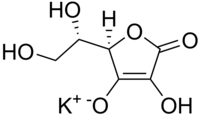
| |
| Names | |
|---|---|
| Preferred IUPAC name Potassium (2R)-2--4-hydroxy-5-oxo-2,5-dihydrofuran-3-olate | |
| Other names Monopotassium ascorbate; Potassium L-ascorbate | |
| Identifiers | |
| CAS Number | |
| 3D model (JSmol) | |
| ECHA InfoCard | 100.035.832 |
| E number | E303 (antioxidants, ...) |
| PubChem CID | |
| UNII | |
| CompTox Dashboard (EPA) | |
SMILES
| |
| Properties | |
| Chemical formula | C6H7KO6 |
| Molar mass | 214.214 g·mol |
| Solubility in water | 98g/100mL |
| Except where otherwise noted, data are given for materials in their standard state (at 25 °C , 100 kPa).
| |
Potassium ascorbate is a compound with formula KC6H7O6. It is the potassium salt of ascorbic acid (vitamin C) and a mineral ascorbate. As a food additive, it has E number E303, INS number 303. Although it is not a permitted food additive in the UK, USA and the EU, it is approved for use in Australia and New Zealand. According to some studies, it has shown a strong antioxidant activity and antitumoral properties.
References
- Burdoch, George A. (1997). Encyclopedia of food and color additives. Boca Raton, Florida: CRC Press. p. 207. ISBN 0-8493-9412-0. Retrieved 2012-09-30.
- UK Food Standards Agency: "Current EU approved additives and their E Numbers". Retrieved 2011-10-27.
- Noshly. "Wise Eating, Made Easy". Noshly. Retrieved 2022-02-06.
- Australia New Zealand Food Standards Code"Standard 1.2.4 - Labelling of ingredients". 8 September 2011. Retrieved 2011-10-27.
- FRAJESE, GIOVANNI VANNI; BENVENUTO, MONICA; FANTINI, MASSIMO; AMBROSIN, ELENA; SACCHETTI, PAMELA; MASUELLI, LAURA; GIGANTI, MARIA GABRIELLA; MODESTI, ANDREA; BEI, ROBERTO (June 2016). "Potassium increases the antitumor effects of ascorbic acid in breast cancer cell lines in vitro". Oncology Letters. 11 (6): 4224–4234. doi:10.3892/ol.2016.4506. ISSN 1792-1074. PMC 4888082. PMID 27313770.
- Cavicchio, Carlotta; Benedusi, Mascia; Pambianchi, Erika; Pecorelli, Alessandra; Cervellati, Franco; Savelli, Vinno; Calamandrei, Duccio; Maellaro, Emilia; Rispoli, Giorgio; Maioli, Emanuela; Valacchi, Giuseppe (2017). "Potassium Ascorbate with Ribose: Promising Therapeutic Approach for Melanoma Treatment". Oxidative Medicine and Cellular Longevity. 2017: 4256519. doi:10.1155/2017/4256519. ISSN 1942-0900. PMC 5632911. PMID 29290903.
- Anichini, C.; Lotti, F.; Longini, M.; Proietti, F.; Felici, C.; Perrone, S.; Buonocore, G. (2012). "Antioxidant effects of potassium ascorbate with ribose therapy in a case with Prader Willi Syndrome". Disease Markers. 33 (4): 179–183. doi:10.3233/DMA-2012-0922. ISSN 1875-8630. PMC 3810693. PMID 22960339.
This article about an organic compound is a stub. You can help Misplaced Pages by expanding it. |